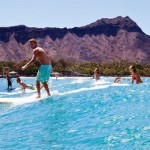What SUP! Surf Standing Up!

Stand up paddle surfing works virtually all muscle groups. Photo: Hawaii Tourism Authority (HTA)/Tor Johnson
One of the best workouts this spring requires you get into a bikini or surf-shorts ASAP. It’s called stand up paddle (SUP) surfing, and you’ll be hooked after your first try.
SUP surfing began on the shores of Waikiki during the 1950s as a hybrid novelty of outrigger canoe paddling and surfing. By using the canoe paddle, local “beachboys” found they were able to move with minimal effort, and so used SUP as a way to better teach tourists and take their photos by using the surfboard as a platform. They also found that the paddle could be used to help carve into turns, thus improving their maneuverability on longer boards.
After the introduction of fiberglass surfboards, SUP experienced a fall from popularity. But when big wave “celebrity” surfers like Brian Keaulana, Laird Hamilton, Dave Kalama, Bruce DeSoto and Mel Puu began using SUPs to train their core and leg muscles for tow-in surfing, a renaissance of the sport was reborn.
“I think so many people are getting into stand up because it’s infectious,” says Keaulana, C4 Waterman co-founder and son of legendary Hawaiian waterman pioneer “Buffalo” Keaulana.
From professional soccer players to Olympic skiers, stunt actors to Lance Armstrong, it seems everyone is literally jumping on board and reaping the health benefits. As Keaulana explains, SUP involves working every single muscle group: “Legs, abs, back, glutes … You’re paddling for such a short time, and when you come in, everything hurts. It’s better than going to the gym.”
One of Keaulana’s buddies dropped 100 pounds in a year merely by stand up paddle surfing in a Newport Beach marina. Another watched his back pains vanish, and another built up his arch muscles and found relief from a life of suffering with flat feet.
As stellar as stand up paddle surfing sounds, like any workout program, there are risks involved. Below is some advice Keaulana has picked up from years of experience:
Learn what you can do first; then, learn what you can’t. “It’s the details—how to control your equipment, how to stop, how to turn left and right—people sometimes overlook when they start out,” Keaulana says. For the best in stand-up paddle equipment and free how-to’s, check out the C4 Waterman official website, www.c4waterman.com
Check the weather and surf conditions before deciding to go to the beach. When you stand up on a surf-board, you act as a human sail. Too-strong winds and currents or too-choppy waves spell trouble for even the most advanced surfers and swimmers out there.
Go to an area that has relatively calm, flat water. You don’t need big waves to build up balance and stamina.
Be respectful of your fellow surfer, swimmer or beach-goer. Keaulana’s personal rule of thumb is to give 20 to 30 feet of distance between yourself and anyone else out on the water. If you fall, you’ll have plenty of room.
Speaking of falling, it is inevitable that you will get thrown for a loop. But the key is falling correctly. By continually being aware of your surroundings—where you are in the ocean, how long your board and leash are, etc.—you can avoid causing serious injury to yourself or others.
Never go out alone. Take along a buddy who is knowledgeable in water safety and CPR, and make sure your cell phone works beforehand.









